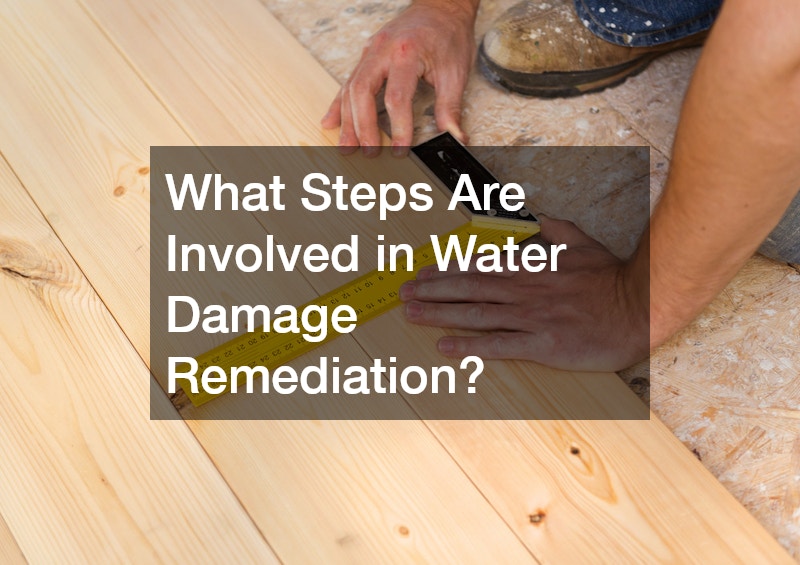Floods and fires cause disruptions far beyond the initial moment of disaster. They affect the health of a home, the safety of the structure, and the emotional well-being of the people who live there. Waterlogged walls, charred framing, lingering smoke, and compromised flooring can create unsafe conditions that demand immediate attention. The overall goal of water and fire damage restoration is not just to clean up visible debris, but to return the home to a safe and comfortable condition through careful remediation and thoughtful remodeling.
Many homeowners use this opportunity to improve their space, whether that means updating finishes, replacing outdated systems, or making long-term resilience upgrades. A project may also involve hiring a bathroom remodeling specialist, a plumbing contractor, an electrical company, an HVAC contractor, or even a painting contractor to ensure the work aligns with modern standards. Regardless of the extent of the damage, understanding the steps involved brings structure and confidence to an otherwise stressful process.
What Are the First Steps After a Flood or Fire?

Ensuring Safety and Evacuation
Safety must come before anything else. After a disaster, hazards such as contaminated water, weakened ceilings, damaged wiring, and airborne toxins can make the home dangerous. A fire alarm left behind may be melted or disabled, electrical systems may be compromised, and structural supports may be unstable. Evacuating the property until emergency responders confirm it is safe is the most important first action. Even if damage looks minimal, unseen risks should never be underestimated.
Contacting Emergency Services
Emergency services assess immediate threats, contain hazards, and determine whether the property is stable. Firefighters verify that smoldering materials are fully extinguished, while utility professionals may shut off gas or electricity. In flood situations, authorities may need to evaluate water contamination or potential sewage exposure. Their oversight ensures that the home is safe enough for an initial inspection.
Assessing Immediate Threats
Homeowners can visually assess the situation from a distance, noting any areas that appear unstable, any remaining smoke, or signs of electrical problems. The presence of buckled floors, sagging ceilings, or large areas of standing water signal potential structural failure. This early observation helps determine which specialists may be needed and correlates to the level of urgency for remediation.
Notifying Insurance Companies
Insurance companies should be contacted as soon as possible. Most require prompt reporting to begin the claims process and to authorize temporary repairs. During this call, homeowners may receive guidance about documentation, preservation of damaged materials, and expectations for inspections. Notifying the insurer early helps prevent delays later in the restoration timeline.
Initial Damage Inspection
Once authorities deem the home safe to enter, a basic walkthrough provides an early understanding of the damage. Walls may show heavy smoke staining, flooring may be warped from water, and insulation may be saturated. While this inspection is not detailed, it gives homeowners a sense of what the recovery process may involve and helps them prepare emotionally and financially for the next steps.
How to Assess the Extent of Damage?
Conducting a Visual Inspection
A visual inspection identifies visible signs of damage such as soot accumulation, mold development, discoloration on surfaces, and warped materials. Homeowners may document these findings using photographs or videos, which are particularly helpful when communicating with insurers and contractors.
Hiring Professional Assessors
While an initial look is informative, only professional assessors can provide an accurate understanding of the full scope of damage. Structural engineers, certified restoration specialists, and environmental testers can uncover hidden issues that are not immediately apparent. Their evaluations provide a foundation for repair planning, ensuring nothing is overlooked.
Checking Structural Integrity
Floods and fires can weaken beams, crack foundations, compromise framing, and damage roof structures. These concerns require evaluation by professionals who understand how moisture, smoke, and heat affect building materials. If the damage is severe, a home contractor may be needed to coordinate reconstruction and ensure the home remains structurally sound.
Evaluating Water and Smoke Damage
Water infiltrates materials quickly, leading to swelling, warping, and mold growth. Smoke penetrates deeply into porous items such as drywall, cabinetry, and insulation, leaving long-lasting odors and contaminants. Moisture meters, air quality sensors, and thermal imaging tools help professionals identify hidden damage and develop a complete remediation plan.
Creating a Detailed Damage Report
A written damage report outlines the findings from the assessment and identifies the materials and systems requiring repair. This report often includes recommendations for specialized work, such as radon testing if soil disruption or foundation shifts occurred during the disaster. It also sets the stage for cost estimates, insurance discussions, and scheduling decisions.
What Steps Are Involved in Water Damage Remediation?

Water Extraction and Drying
Removing water quickly prevents further deterioration. Pumps, industrial vacuums, and drying equipment extract standing water, while commercial fans and dehumidifiers continue the drying process. Moisture removal can take several days, depending on the saturation level and materials affected.
Mold Prevention and Treatment
Moisture creates favorable conditions for mold, which may begin forming within 24 to 48 hours. Mold prevention includes applying antimicrobial treatments, controlling humidity, and removing contaminated materials. If mold is already present, professional remediation teams isolate the area and remove affected sections safely.
Repairing Water-Affected Structures
Drywall, insulation, and flooring heavily exposed to water may need to be replaced. Wood framing may be preserved if drying is effective, although some pieces may require reinforcement or replacement. Structural repairs are usually handled by a home contractor familiar with water-damaged properties.
Sanitation and Deodorization
Floodwater often contains bacteria, debris, and contaminants that must be cleaned thoroughly. Sanitation ensures the home becomes safe for occupancy again, while deodorization removes odors caused by mold, mildew, or dirty water. The use of specialized cleaning agents and filtration equipment helps restore healthy indoor air.
Preventing Future Water Intrusion
After remediation, homeowners may choose to seal basement walls, improve foundation drainage, upgrade sump pumps, or reinforce roof systems to reduce the risk of future water damage. Consulting with an HVAC contractor can also help eliminate humidity issues that contribute to long-term moisture problems.
How to Conduct Fire Damage Cleanup and Restoration?
Assessing Fire and Smoke Damage
Fire damage extends beyond burned surfaces. Heat can warp structural components, smoke can infiltrate materials, and firefighting efforts often leave large amounts of water behind. A detailed assessment identifies what can be salvaged and what must be replaced.
Removing Soot and Smoke Residue
Soot removal requires specialized vacuums, sponges, and chemical solutions to avoid spreading contamination. Smoke may linger in materials such as cabinets, carpeting, and insulation, requiring deep cleaning or replacement. Smoke odor removal often involves air scrubbers and sealing agents applied to walls before repainting.
Repairing and Replacing Damaged Materials
Charred framing, melted wires, broken windows, and damaged plumbing fixtures often require comprehensive repair. An electrical company may need to inspect or replace wiring to restore safety, while a plumbing contractor may repair water lines affected by the heat. This phase blends restoration work with remodeling decisions—many homeowners choose upgrades like a granite countertop, modern lighting, or improved layouts during this time.
Addressing Water and Chemical Damage from Fire Suppression
Water used during fire suppression can be as damaging as the fire itself, introducing moisture that may lead to mold. Chemical extinguishing agents can leave residue on surfaces and must be properly cleaned. Restoration teams dry the area, neutralize chemicals, and replace materials that cannot be salvaged.
Ensuring Safe Air Quality
After a fire, air quality can remain poor for weeks without proper mitigation. Air scrubbers, HEPA filtration, and ventilation improvements help remove lingering toxins. Additional testing verifies that the home is safe to breathe in again.
How to Deal with Insurance Claims?

Documenting the Damage
Photographs, videos, receipts, and written descriptions provide critical documentation for insurance claims. This includes recording damaged items, structural issues, and immediate expenses incurred during the evacuation period.
Understanding Insurance Policy and Coverage
Policies vary significantly, and coverage may depend on the type of damage, the cause of the incident, and the specifics of the policy language. Some policies fully cover water and fire damage restoration, while others have limitations that must be reviewed carefully.
Working with Insurance Adjusters
Insurance adjusters assess damage and determine compensation amounts. Being present during inspections and providing detailed documentation helps ensure a fair evaluation. Some homeowners hire professionals to negotiate or clarify disputed areas.
Filing and Tracking Your Claim
Submitting your claim promptly and maintaining communication with your insurer helps expedite the process. Tracking every conversation and keeping records of repair estimates, invoices, and contractor statements ensures transparency and smoother interactions.
Dealing with Denied Claims
If a claim is denied, homeowners may submit an appeal or seek additional evidence. In some cases, third-party assessments or legal guidance may be necessary to challenge the decision.
What Are the Essential Tools and Equipment Needed?
Water Extraction Tools
Equipment such as pumps, wet vacuums, and water extraction mats remove standing water and reduce structural damage.
Cleaning and Sanitizing Equipment
Steam cleaners, disinfectants, and specialized deodorizing machines help restore safe living conditions after contamination.
Safety Gear for Remediation Workers
Respirators, gloves, protective suits, and goggles keep workers safe from mold spores, ash, chemicals, and harmful debris.
Air Quality Control Devices
Air scrubbers, HEPA filters, and dehumidifiers maintain safe indoor environments during remediation and prevent moisture-related issues.
Structural Repair Tools
Framing tools, saws, thermal cameras, and moisture meters guide the process of rebuilding and ensure accuracy throughout restoration.
How to Choose the Right Restoration Professional?
Checking Credentials and Certifications
A reputable restoration company should have certifications that demonstrate proper training in fire, water, and mold remediation. These qualifications confirm that the contractor follows industry standards.
Evaluating Experience and Past Projects
Experience is invaluable in restoration projects. Reviewing portfolios and previous work samples helps homeowners learn how a contractor has handled similar cases.
Getting Multiple Quotes and References
Multiple quotes provide insight into fair pricing and potential red flags. Asking for references helps confirm the reliability of the contractor.
Understanding Their Remediation Process
Professionals should clearly outline their approach to remediation and explain expected timelines. This includes cleanup strategies, repair processes, and collaboration with other experts such as an HVAC contractor or plumbing contractor.
Reviewing Contracts and Guarantees
A strong contract outlines responsibilities, costs, and warranties. Guarantees provide reassurance that the work will be corrected if problems arise later.
What Are the Costs Involved in Remediation and Restoration?
Initial Assessment and Consultation Fees
Some companies offer free consultations, while others charge for detailed inspections or environmental testing. These fees vary depending on the type and severity of damage.
Labor and Material Costs
Labor is typically the most significant portion of a restoration budget. Material replacement costs vary depending on the selections—a granite countertop, upgraded flooring, or new lighting can influence the total expense.
Insurance and Out-of-Pocket Expenses
Policies may cover part or all of the remediation, but deductibles and exclusions can still result in personal costs. Reviewing your coverage early helps avoid financial surprises.
Potential Hidden Costs
Hidden damage behind walls, beneath floors, or within utility systems may surface during repairs. This can include mold growth, electrical hazards, or plumbing issues requiring immediate attention.
Financing and Payment Plans
Restoration companies often offer financing options to help homeowners begin repairs without waiting for full insurance reimbursement.
How Long Does the Remediation Process Take?
Varying Timeframes for Different Damage Levels
Minor water damage may be resolved within days, while extensive fire destruction can take months. The timeframe depends on the severity of damage, the size of the home, and the complexity of repairs.
Factors Influencing Time to Completion
Contractor availability, insurance delays, moisture levels, material shortages, and structural complications all affect the timeline.
Efficient Project Management
Coordinated scheduling among contractors—such as the electrical company, HVAC contractor, and painting contractor—helps reduce downtime and maintain steady progress.
Managing Delays and Scheduled Setbacks
Unexpected discoveries, weather impacts, and supply issues can contribute to schedule changes. Clear communication between the homeowner and contractor is essential to navigate these challenges.
Providing Homeowners with Timelines
Restoration professionals typically provide projected timelines outlining key milestones. These help homeowners plan temporary housing or adjustments to daily routines.
What Measures Can Be Taken to Prevent Future Damage?

Installing Flood Barriers and Detectors
Water sensors, sump pumps, and foundation barriers help reduce the risk of future flooding. Some homeowners also install improved drainage or reinforce basement walls.
Creating a Fireproof Home Environment
Fire-resistant materials, safer electrical setups, updated wiring, and regular testing of the home’s fire alarm system increase fire safety.
Regular Home Maintenance and Inspections
Routine maintenance helps identify problems before they become disasters. Checking the roof, plumbing fixtures, gutters, and HVAC systems reduces risks associated with wear and deterioration.
Educating Families on Emergency Response
Teaching family members how to respond to alarms, shut off utilities, and safely evacuate ensures everyone is prepared for emergencies.
Upgrading Home Infrastructure
Many homeowners use post-disaster remodeling as an opportunity to upgrade outdated areas. Improvements such as modern insulation, new ventilation systems, bathroom remodeling, or enhanced electrical panels increase comfort and resilience.
Closing Thoughts
Restoring a home after a flood or fire is a major undertaking that requires skilled professionals, careful planning, and proactive decision-making. By addressing damage quickly, coordinating with the right contractors, and investing in strong remediation practices, homeowners can rebuild a safe, healthy, and comfortable environment. Understanding each stage of the process also empowers families to make improvements that strengthen the home’s long-term durability and reduce the risk of future disasters.



